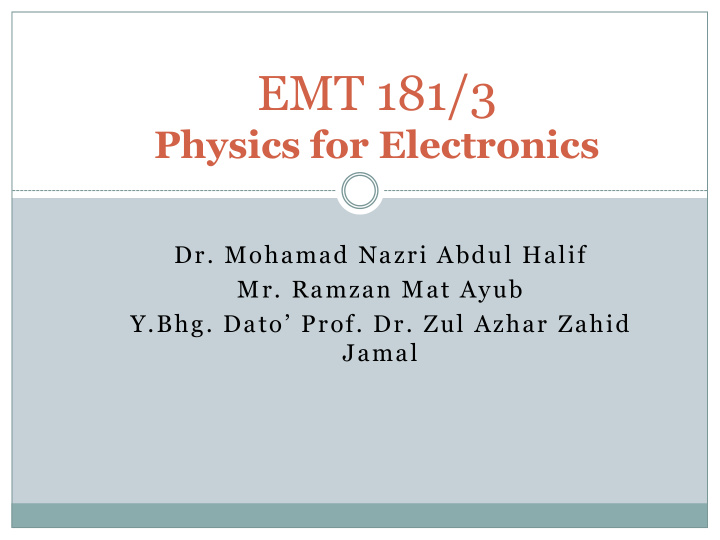



EMT 181/3 Physics for Electronics Dr. Mohamad Nazri Abdul Halif Mr. Ramzan Mat Ayub Y.Bhg. Dato ’ Prof. Dr. Zul Azhar Zahid Jamal
Synopsis EMT 181 This course provides the principles of Physics, specifically as a foundation course for electronics, microelectronics and photonics. It is a calculus based course. The course is similar to undergraduate basic physics course consisting from classical physics of mechanics, thermodynamics, basic optics, electricity and magnetism, modern physics and the introductory to the electric conductivity for solid.
Course Outcomes (Cos) CO1 : Ability to understand and formulate the principle concepts of physics in mechanics, waves and thermodynamics. CO2: Ability to explain and calculate the principles of electricity and magnetism in basic electronics. CO3: Ability to analyze and solve the problems related to the principles of optics and modern physics specifically on physics of materials.
Syllabus CHAPTER 1 : BASIC MECHANICS (Week 1 – Week 3) – Dr. Nazri (8 Hours) 1.1 Physics and Measurement 1.2 Motion in 1-Dimension 1.3 Vectors 1.4 Motion in 2-Dimension & 3-Dimension 1.5 The Laws of Motion & Applications 1.6 Work & Energy 1.7 Linear and Angular Momentums 1.8 Static Equilibrium and Elastically 1.9 Fluid Mechanics
Syllabus CHAPTER 2 : OSCILLATION AND WAVES (Week 4 – Week 5) – Mr. Ramzan (6 Hours) 2.1 Oscillatory Motion 2.2 Wave Motion 2.3 Sound Waves 2.4 Superposition & Standing Waves
Syllabus CHAPTER 3 : THERMODYNAMICS (Week 6 – Week 8) – Mr. Ramzan (9 Hours) 3.1 Temperature & Kinetic Theory of Gases 3.2 Heat & The 1 st Law of Thermodynamics 3.3 Entropy & The 2 nd Law of Thermodynamics 3.4 Thermal Properties and Processes 3.5 The Transfer of Heat 3.6 Introduction to Thermal Analysis for Electronic Systems
Syllabus CHAPTER 4 : ELECTRICITY AND MAGNETISM (Week 9 – Week 11) – Mr. Ramzan/Dato ’ Prof. Dr. Zul Azhar 4.1 The Electric Field I: Discrete Charge Distributions 4.2 The Electric Field II: Continuous Charge Distributions 4.3 Electric Potential 4.4 Capacitance & Dielectrics 4.5 Electric Current & Direct-Current Circuits 4.6 The Magnetic Forces, Fields & Its Sources 4.7 Magnetic Induction
Syllabus CHAPTER 5 : LIGHT, OPTICS AND MODERN PHYSICS (Week 12 – Week 14) – Dr. Nazri (9 Hours) 5.1 The Nature of Light 5.2 Image Formation 5.3 Interference and Diffraction 5.4 From Newton to Einstein 5.6 Photons and Matter Waves 5.7 Atoms, Molecules and Solids 5.8 Conduction of Electricity in Solids
Evaluation contribution Examination: 80% Mid Term Examinations = 20% Final Examination = 60% Continual Assessment: 20% Quizzes = 20%
Tutorial Sessions/Mid Term Exam THREE (3) tutorial sessions for 5 Groups: Session 1: Week 6 Session 2: Week 10 or Week 11 Session 3: Week 14 (Time and Place will be arrange later – announcement in the portal) • MID-TERM EXAM – Week 7 (Time and Place will be arrange later – announcement during lecture/in the portal)
List of references P.A. Tipler and G. Mosca , “Physics for Scientist and Engineers (with Modern Physics)”, Freeman Company (2008). Serway and Jewett, “Physics for Scientist and Engineers (with Modern Physics)”, 9 th ed., Brooks/Cole, (2013). W. Bauer, G.D. Westfall, “University Physics with Modern Physics”, McGraw Hill, (2014). D. Halliday and R. Resnick , “Fundamental of Physics”, Ext. 7 th Ed. Wiley, (2004). A.D. Kraus, A.V- Cohen, “Design and Analysis of Heat Sinks (Thermal Management of Microelectronic and Electronic System Series)”, Wiley -Interscience, (1995). # Or any other University Physics textbooks.
The Big Picture Astrophysics NEWTONIAN PHYSICS Nanotechnology String Biophysics Theory High-Energy/ Particle Complexity Physics MODERN PHYSICS & Chaos (20 th & 21 st century & beyond) Energy & Quantum Power Computing Condensed Quantum Matter Physics Physics & Electronics
Why Study Physics ? Physics is the science (root) on which all other natural and engineering sciences are built. All modern technological advances – from laser surgery to television, from computers to refrigerators, from cars to airplanes – track back directly to Basic Physics. Through consistent theories, and, well-design experiments, physics has help us obtain a deeper understanding of our surroundings.
Why Study Physics ?
Recommend
More recommend